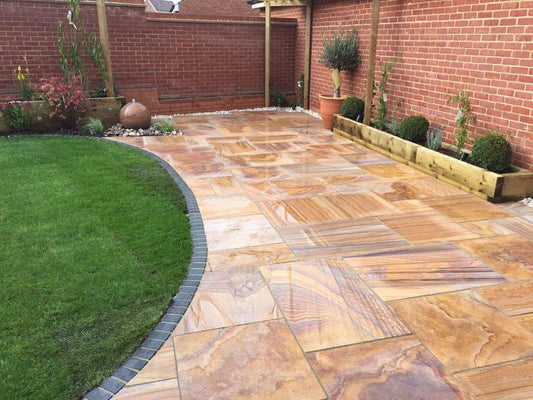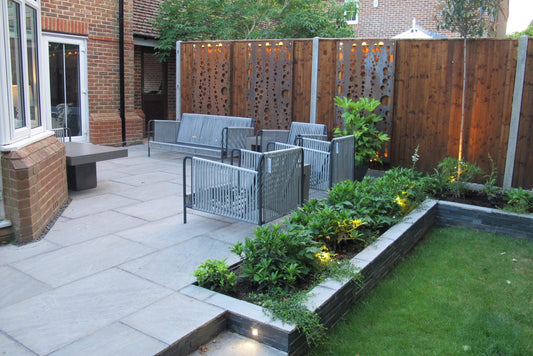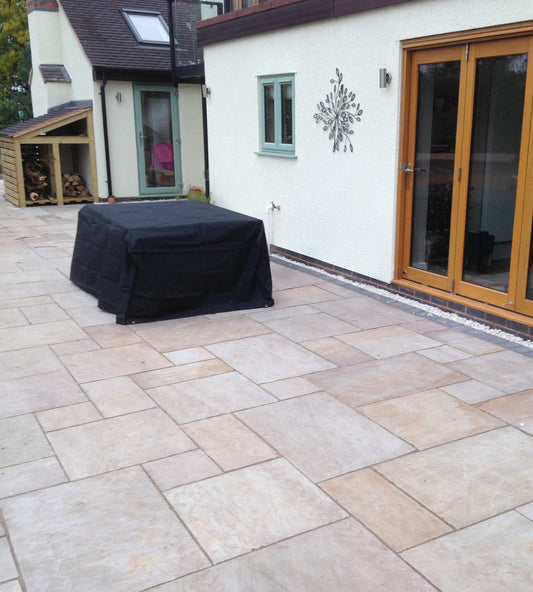
What is Porcelain Paving?
Share
Are you considering adding porcelain paving to your outdoor space? It's important to weigh the pros and cons before making a decision. The durability, low maintenance, and design options make porcelain an attractive choice, but you may also have concerns about its cost and potential for cracking. Let's explore the advantages and disadvantages together.
| Paving Type | Advantages | Disadvantages |
|---|---|---|
| Porcelain Paving |
|
|
| Concrete Paving |
|
|
| Sandstone Paving |
|
|
| Composite Paving |
|
|
Key Takeaways:
- Porcelain paving is a great material choice for outdoor areas such as patios, al fresco dining areas, and seating spots.
- The benefits of porcelain paving include its high quality, durability, low maintenance, and non-porous nature.
- However, there are some disadvantages to consider, such as the cost, slippery surface when wet, limited color options, and difficulty in installation.
- Some alternatives to porcelain paving include natural stone, concrete paving, and composite paving, each with their own unique features and benefits.
What Is Porcelain Paving?
Porcelain paving is a durable and versatile type of outdoor flooring made from ceramic material. It is a popular choice for patios, walkways, and other outdoor areas, including seating spots.
Porcelain paving offers numerous benefits, including:
- Resistance to stains, frost, and fading
- Easy maintenance and cleaning
With its stylish and modern appearance, it can enhance the aesthetic and functionality of your outdoor space, making it an ideal setting for al fresco dining or creating a comfortable seating spot.
Consider using porcelain paving for your outdoor projects to elevate the look and functionality of your outdoor areas.
What Are The Advantages Of Porcelain Paving?
When considering a material for your outdoor paving needs, it's important to make an informed decision by weighing the pros and cons. Porcelain paving, made from kiln-fired dense natural clays at extreme temperatures, offers many advantages that make it a popular choice among homeowners. In this section, we will explore the benefits of porcelain paving, including its durability when properly laid on a good bedding, low maintenance due to its low porosity, and ease of cleaning with the use of pressure washers and inkjet printing technology.
1. Durability
Durability is a key advantage of porcelain paving due to its high quality and proper installation techniques. To ensure its long-lasting performance, follow these steps:
- Choose a reputable supplier that offers high-quality porcelain paving.
- Ensure the paving is properly laid on a good bedding of mortar or concrete.
- Opt for porcelain paving made from dense natural clays that are kiln fired at extreme temperatures for increased strength.
- Regularly inspect and maintain the paving to identify any issues and address them promptly.
By following these steps, you can maximize the durability of your porcelain paving and enjoy its benefits for years to come.
2. Low Maintenance
- Regular Cleaning: Sweep or hose down the porcelain paving regularly to remove dirt and debris.
- Avoid Harsh Chemicals: Use mild soap or detergent and water for cleaning. Avoid using acidic or abrasive cleaners.
- Periodically, you can use a pressure washer on a low setting to deep clean the paving.
- Stain Prevention: Quickly clean up spills to prevent staining. Use a mild cleaning solution for stubborn stains.
- Inspect for Damage: Regularly inspect the paving for any cracks or damage and repair as needed.
True story: A homeowner installed porcelain paving in their backyard and found it incredibly easy to maintain. With regular cleaning and occasional use of a pressure washer on a low setting, the paving remained in excellent condition for years. The low porosity of the porcelain prevented stains, and the low maintenance required allowed the homeowner to spend more time enjoying their outdoor space.
3. Non-porous
Porcelain paving is well-known for its non-porous nature, which offers numerous benefits. To fully take advantage of this characteristic, follow these steps:
- Preparation: Make sure the area is free of debris and dirt.
- Cleaning: Use a pressure washer on a low setting to remove any stains or dirt from the surface.
- Sealing: Apply a sealant to further enhance the non-porous properties and protect against potential staining.
- Maintenance: Regularly sweep and clean the surface to prevent the buildup of dirt or grime.
By following these steps, you can maintain the low porosity of porcelain paving and keep it looking pristine for years to come. Just remember to use pressure washers on low settings to avoid causing damage to the surface.
4. Easy to Clean
Cleaning porcelain paving is a simple process that can be accomplished with basic tools and techniques. Follow these steps to effectively clean your porcelain paving:
- Start by sweeping or using a leaf blower to remove any loose dirt, leaves, or debris from the surface.
- Mix a mild detergent or soap with water to create a cleaning solution.
- Apply the cleaning solution to the paving using a mop or a soft-bristle brush.
- Gently scrub the surface to remove any stains or grime.
- Rinse the paving thoroughly with clean water.
- If necessary, use a pressure washer on a low setting to remove stubborn dirt or stains.
- Allow the paving to dry completely before using it again.
It's important to keep in mind that while porcelain paving is easy to clean, it should not be treated with harsh chemicals or abrasive materials that can cause damage to the surface. Additionally, the use of inkjet printing technology in porcelain paving ensures vibrant and long-lasting colors.
What Are The Disadvantages Of Porcelain Paving?
When considering porcelain paving for your outdoor space, it is important to make an informed decision by weighing both the pros and cons of this material. While there are many advantages to using porcelain paving, such as its durability and low maintenance, there are also some disadvantages that should be taken into consideration. In this section, we will discuss the cons of porcelain paving, including its cost, potential slipperiness when wet, limited color options, and difficulty of installation. By understanding these drawbacks, you can determine if porcelain paving is the right choice for your project.
1. Cost
Porcelain paving offers many advantages, but cost can be a disadvantage. Here are some steps to consider when evaluating the cost of porcelain paving:
- Research prices: Compare the cost of porcelain paving from different manufacturers and suppliers.
- Budget evaluation: Determine your budget and assess if it aligns with the cost of porcelain paving.
- Consider long-term costs: While porcelain paving might have a higher upfront cost, it may require less maintenance and have a longer lifespan, potentially reducing long-term expenses.
- Explore alternatives: Investigate alternative paving options such as concrete or natural stone, which may offer a lower cost.
- Weigh pros and cons: Consider the advantages and disadvantages of porcelain paving in relation to your specific needs and budget.
2. Slippery When Wet
When considering the disadvantage of porcelain paving being slippery when wet, there are steps that can be taken to minimize the risk of accidents.
- Apply an anti-slip coating to the surface of the porcelain tiles.
- Use textured porcelain tiles that provide better traction.
- Ensure proper drainage so that water doesn't accumulate on the surface of the paving.
- Regularly clean the surface to remove any dirt or debris that may make it more slippery.
By following these steps, the slipperiness of porcelain paving can be mitigated, making it a safer option for outdoor spaces.
3. Limited Color Options
Porcelain paving offers many advantages, but one of its drawbacks is its limited color options. While natural stone or concrete paving comes in a wide range of colors and patterns, porcelain paving tends to have a more restricted color palette. This may be a disadvantage if you have a specific color scheme in mind for your outdoor space. However, it's worth noting that with advancements in technology, manufacturers are now able to create porcelain pavers that imitate the appearance of natural stone or concrete, providing more color options. If you're set on a particular color, it's recommended to explore different brands and collections to find the closest match.
4. Difficult to Install
Installing porcelain paving can be a challenging task, but with proper planning and execution, it can be accomplished effectively. Here are some steps to help simplify the laying paving slabs process:
- Prepare the area: Clear the space of any debris or vegetation. Ensure the ground is level and compact.
- Lay a solid base: Use a layer of crushed stone or gravel as a stable and draining foundation.
- Create a mortar bed: Apply a layer of mortar onto the base, ensuring it is even and smooth.
- Place the porcelain pavers: Carefully lay the pavers onto the mortar bed, making sure they are evenly spaced and aligned.
- Secure the pavers: Use a rubber mallet to gently tap each paver into place, ensuring they are level and stable.
- Point the patio: After the pavers are securely in place, it's essential to properly point the patio by filling the joints between the pavers.
- Fill the joints: Fill the gaps between the pavers with grout or paving sand to provide stability and prevent weed growth.
- Finishing touches: Clean any excess grout or sand from the surface of the pavers and allow them to set according to the manufacturer's instructions.
What Are The Alternatives To Porcelain Paving?
As with any home improvement project, it's important to consider all options before making a decision. In this section, we will discuss the alternatives to porcelain paving, including concrete paving, natural stone paving, and composite paving. Each of these alternatives have their own pros and cons, and we will dive into the details of each to help you determine which may be the best fit for your specific needs. From the durability of concrete paving to the natural beauty of stone paving, we'll explore the various factors to consider when choosing the right paving material for your outdoor space.
1. Concrete Paving
Concrete paving is a popular alternative to porcelain paving, offering durability, affordability, and versatility. To install concrete paving, follow these steps:
- Prepare the area by removing any existing vegetation and leveling the ground.
- Create a solid base by compacting the soil and adding a layer of gravel or sand.
- Build a frame using wooden or metal stakes and boards to contain the concrete.
- Mix the concrete according to the manufacturer's instructions and pour it into the frame.
- Use a screed board to level the surface and remove any excess concrete.
- Smooth the surface with a trowel and add any desired decorative features.
- Allow the concrete to cure for the recommended time before using it for driveways, patios, walkways, or pool decks. It can even be stained or stamped to mimic other materials, making it a cost-effective and durable solution for outdoor spaces.
2. Natural Stone Paving
When looking for alternatives to porcelain paving, natural stone paving is a popular and elegant choice. Here are some steps to follow when using natural stone paving:
- Choose the type of natural stone you prefer, such as granite, limestone, or sandstone.
- Consider the size and shape of the stones to create a desired pattern or design.
- Ensure that the natural stone has a textured surface to provide slip resistance and improve safety.
- Select a stone that is fade resistant to maintain its color over time.
- Prepare the ground by excavating and leveling the area before laying the stones.
- Use a suitable adhesive or mortar to securely fix the stones in place.
- Finish the installation by filling the gaps between the stones with sand or jointing compound.
Fun Fact: Adding natural stone paving to any outdoor space can bring a touch of elegance and natural beauty.
3. Composite Paving
Composite paving is a popular alternative to porcelain paving, offering several benefits. If you are considering this option, here are some steps to keep in mind:
- Research: Take the time to explore various composite paving options and compare their features, such as durability, maintenance requirements, and cost.
- Choose a reputable supplier: It is important to select a trusted supplier that offers high-quality composite paving materials.
- Prepare the area: Before installation, make sure to clear the area of any existing paving and ensure a level and stable base.
- Install the paving: Follow the manufacturer's instructions for installing the composite paving, ensuring proper alignment and spacing.
- Maintain and clean: To keep your composite paving in good condition, make sure to regularly sweep and clean it.
Keep in mind that composite paving offers a durable and low-maintenance option, although it may have limited color choices compared to other alternatives such as concrete or natural stone paving. However, it can still be a great choice for various outdoor projects.
FAQs about Porcelain Paving Pros And Cons
Is porcelain a good material choice for outdoor paving?
Yes, porcelain is a fantastic material choice for creating a beautiful and hardwearing patio or terrace. Its durability, low maintenance, and wide range of options make it a popular choice for outdoor spaces.
Are there any disadvantages to using porcelain paving?
While porcelain has many advantages, it can be tricky to lay and requires specialized tools for cutting and drilling. It is also more expensive than some other paving materials and may not suit more traditional garden designs.
Can porcelain paving withstand extreme temperatures?
Yes, porcelain is frost-proof and won't be affected by extreme temperatures. Its low porosity also makes it resistant to moisture, preventing algae and mold buildup and making it slip-resistant even in cold weather or textured surfaces.
How long can I expect porcelain paving to last?
With proper installation and maintenance, porcelain paving can last for decades, even up to 50 years. Its density and kiln-firing process make it a highly durable material, making it a worthwhile investment in your outdoor space.
Is porcelain paving a good choice for outdoor dining areas?
Yes, porcelain is a great choice for outdoor dining areas, as its slip-resistant properties and resistance to fire make it a safe and practical option. Its wide range of colors, sizes, and patterns also allow for a customized and stylish design for your outdoor dining space.
Can I install porcelain paving myself?
While porcelain paving can be DIY-friendly, it can be tricky to lay and requires specialized tools. It is recommended to consult with a professional for proper installation to ensure the longevity and quality of your outdoor space.
What are some popular sizes for porcelain paving slabs?
Popular sizes for porcelain paving slabs include 900 x 450 paving and 900 x 600 pavers, offering versatility for different outdoor spaces.
How can I add unique color to my patio with sandstone paving?
For a unique color palette, consider rainbow sandstone paving or ivory smooth paving for a distinct and elegant look.
Are there any smaller paver options for intricate paving designs?
Yes, 600 x 600 pavers are great for intricate designs, offering a compact yet versatile option for various layouts.
What are some cost-effective paving solutions?
For cost-effective solutions, explore discount paving options. They provide affordable choices without compromising on quality.
How do I maintain the appearance of my porcelain paving?
Maintaining porcelain paving is straightforward. For tips on upkeep, including cleaning paving without a pressure washer, there are several effective methods available.
What should I consider when choosing the sub-base for my paving?
Choosing the right Paving Sub Base is crucial for the longevity and stability of your paving. It's important to select the appropriate materials and thickness.
How can I prevent weeds from growing in my block paving?
To stop weeds in block paving, regular maintenance and the use of proper jointing and sealing techniques are key.






